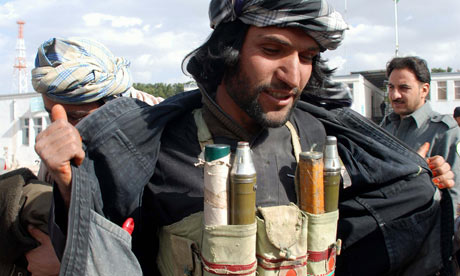Militants Turn to Death Squads in Afghanistan

http://www.nytimes.com/2011/11/29/w...-use-death-squads-in-afghanistan.html?_r=2&hp

SABARI, Afghanistan As targeted killings have risen sharply across Afghanistan, American and Afghan officials believe that many are the work of counterintelligence units of the Haqqani militant network and Al Qaeda, charged with killing suspected informants and terrorizing the populace on both sides of the Afghanistan-Pakistan border.
Military intelligence officials say that the units essentially act as death squads and that one of them, a large group known as the Khurasan that operates primarily in Pakistans tribal areas, has been responsible for at least 250 assassinations and public executions.
Another group, whose name is not known, works mainly in Afghanistan and may be responsible for at least 20 killings in Khost Province over the summer alone, including a mass beheading that came to light only after a video was found in the possession of a captured insurgent. The video shows 10 headless bodies evenly spaced along a paved road, while their heads sit nearby in a semicircle, their faces clearly visible.
It is another indication that the Haqqanis, a mostly Pakistan-based faction, remain the most dangerous part of an insurgency that makes full use of a porous and often ill-defined border, as the NATO strike that killed 24 Pakistani soldiers over the weekend showed.
Though the circumstances of that strike remain murky, it has now further upset relations between Pakistan and the United States, even as it once again demonstrated how havens inside Pakistan remained a critical part of the insurgent strategy.
The Americans have geared their offensive around bloodying the insurgents as they enter Afghanistan. But the new wave of assassinations shows that, even as NATO portrays the insurgents as a weakening force, the Haqqanis can still assert their influence, not only with headline-grabbing bombings but also through intimidation and by controlling perceptions.
One chilling case attributed to the second death squad came after American forces captured the senior Afghanistan-based leader for the Haqqanis, Hajji Mali Khan, and killed his top deputy this summer. Just days later, the bodies of two men accused of helping the Americans turned up near the village where Mr. Khan was captured. Scalding iron rods had been shoved through their legs. One victim had been disemboweled, and both had been shot through the head and crushed by boulders. Fear shot through the entire village.
You could hardly recognize them, said a witness who viewed the bodies.
Across Afghanistan, assassinations have jumped 61 percent, to 131 reported killings, through the first nine months of this year, compared with the same period in 2010, according to NATO statistics. United Nations officials say they began noticing a sharp increase in 2010, with 462 assassinations according to their records, double the number from the previous year. The figures may not include many killings in remote areas, like the mass beheading, because fearful villagers never reported them.
American intelligence officials say the Afghanistan-based group and the Khurasan seem to operate in much the same manner. The Khurasan is believed to have formed in early 2009 in the North Waziristan area of Pakistan, the Haqqanis headquarters, in response to intensified drone attacks by the United States. The group is said to wear black clothing with green armbands bearing its full name, Itihad al-Mujahedeen Khurasan, and works closely with Al Qaeda in the region. Estimates of its size range from 100 to 2,000 members.
http://www.nytimes.com/2011/11/29/w...-use-death-squads-in-afghanistan.html?_r=2&hp

